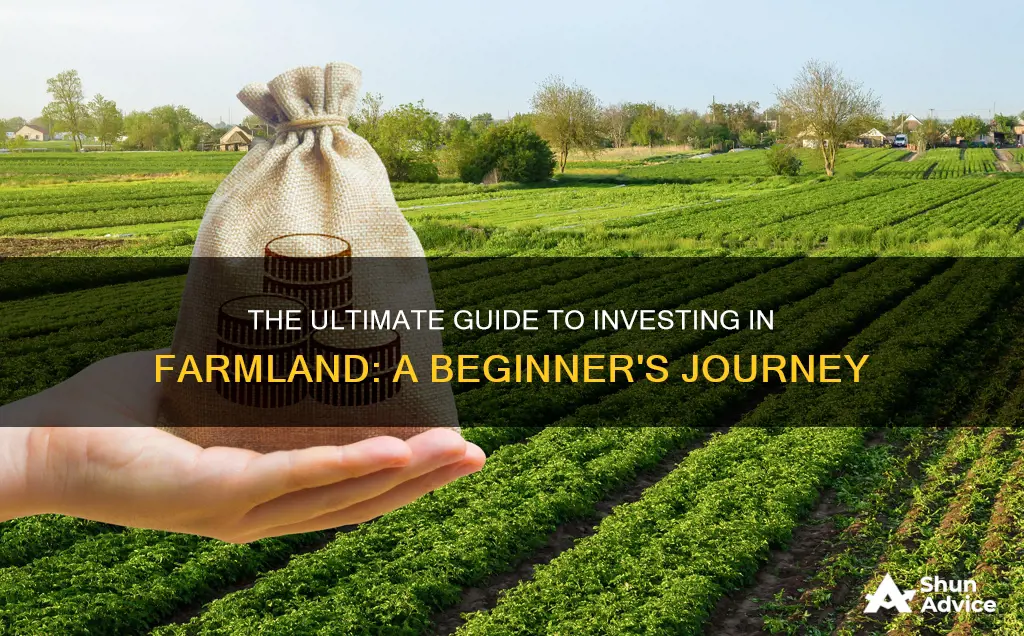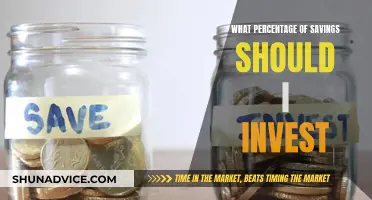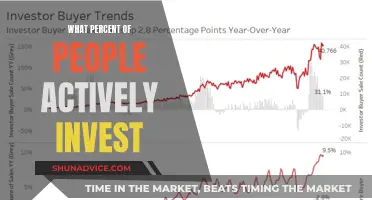
Investing in farmland can be a great way to diversify your portfolio, but it's not a feasible strategy for the average investor due to the large capital commitment required. However, there are now several ways to gain exposure to the sector without sinking money into a farm, such as investing in agriculture-focused real estate investment trusts (REITs) or crowdfunding platforms. These options can provide investors with passive income opportunities and diversification benefits, but it's important to remember that there are also risks associated with farmland investing, including vacancy, weather, and political tensions.
| Characteristics | Values |
|---|---|
| Investment type | Alternative investment |
| Investment benefits | Diversifies portfolio, smooths out risk, solid returns |
| Investment risks | Liquidity, knowledge, volatility, vacancy, weather, politics |
| Investment options | Direct purchase, REITs, crowdfunding, farmland lending, farm debt, commodities, ETFs, mutual funds |
| Farmland uses | Crops, pastureland, urban farm |
| Farmland returns | Increases in farmland values, crop yields, cash rental payments |
| Farmland volatility | Less volatile than most asset classes |
| Farmland and inflation | Natural hedge against inflation |
| Farmland and taxes | Depreciation, mortgage interest, capital gains, repairs, services, utilities, travel costs, tax incentives |
What You'll Learn

Farmland REITs
Farmland Real Estate Investment Trusts (REITs) are a relatively new phenomenon, providing a way for anyone to invest in farmland, which has historically been an excellent asset class. Farmland REITs are a subset of traditional REITs, focusing on the agricultural industry.
How They Work
- They provide farmers with access to capital by acquiring land and leasing it back to them under long-term leases.
- They introduce farmland as an asset class to investors, who receive regular dividend payments.
REITs enable investors to buy just a few shares on public exchanges, rather than purchasing an entire property, making them more liquid and affordable. They also provide portfolio diversification, as their returns are often uncorrelated with common equities.
Examples of Farmland REITs
There are currently two main agricultural REITs:
- Gladstone Land Corporation (LAND): The largest farmland REIT globally by market value, owning stakes in over 150 farms across 14 states, with a focus on fruit and produce farms.
- Farmland Partners Inc. (FPI): The second-largest farmland REIT by market cap, with holdings of over 157,000 acres across 16 states. Over 100 tenants produce 26 types of commercial crops.
Risks and Benefits
Like any investment, REITs carry risks. They are subject to interest rate fluctuations, natural disasters, and challenges with farmer-tenants. They also have significant tax implications, as they must pay property taxes, which can account for a large portion of operating costs.
However, farmland REITs have historically produced attractive long-term total returns, boosted by land value appreciation and crop-driven rental income. They have also been an excellent hedge against inflation and are less volatile than other asset classes.
Planning for Retirement: A Step-by-Step Guide to Investing
You may want to see also

Farmland crowdfunding platforms
Crowdfunding platforms are a great way to invest in farmland without having to buy a farm yourself. These platforms allow investors to pool their money together to purchase farmland and, in some cases, manage the farmland collectively.
AcreTrader
AcreTrader is one of the newer farmland investing platforms, founded in 2018. It is a crowdfunding platform that allows investors to pool their money to purchase deals. The platform has funded 127 properties, totalling over $365 million in equity raised and has nearly 40,000 acres of farmland in its portfolio. Most deals involve farmers selling their farms to investors, who then hold the property for several years before selling it. While the property is being held, it is rented out to another farmer to generate income for investors. Returns on the platform vary based on each project, with most projects offering a cash yield of 3-7% and an overall return of 8-12%. The minimum investment on AcreTrader is $10,000 to $25,000, and the platform is currently only open to accredited investors.
FarmTogether
FarmTogether is a farmland investment manager providing accredited and institutional investors with access to institutional-quality farmland offerings in prime growing regions across the US. Their all-in-one platform offers various products, including crowdfunded farmland offerings, 1031 exchanges, sole ownership bespoke offerings, and the Sustainable Farmland Fund. The company was founded in 2017 and has raised over $14 million in venture capital funding. The FarmTogether management team has extensive experience in farmland investing, investment management, agriculture, and ag-tech, with $1.2 billion in collective deployed capital. They target opportunities that typically yield 6-13% returns with 2-9% cash yields, all net of fees. The minimum investment for their crowdfunded offerings is $15,000.
FarmFundr
FarmFundr is a farmer-owned, equity crowdfunding platform focused on specialty crop operations in the United States. They offer fractional farmland ownership opportunities to their members, with a minimum investment of $10,000. FarmFundr manages all aspects of the farmland, from planting to harvesting to selling, while investors simply monitor their farm's progress online. Profits from crop sales are distributed to investors annually, and at the end of the holding period, they will receive their share of the land sale profits.
Harvest Returns
Harvest Returns is a crowdfunding platform that has been providing a way for farmers to raise funds and investors to generate returns since 2016. The platform has raised over $11 million and funded 23+ different farms. What sets Harvest Returns apart is their partnership approach with farmers, working with them to ensure they can get what they need from the platform. Deals on the platform can be structured as debt or equity, and they allow non-accredited investors to participate in many deals. The minimum investment on Harvest Returns is $10,000.
Steward
Steward is a unique crowdfunding platform that exclusively offers debt or lending opportunities. The platform was launched in 2016 to provide small independent farmers, ranches, and fisheries with access to capital. Investors can invest through the Evergreen fund, which supports several campaigns, or choose specific lending opportunities released periodically. The platform has a low minimum investment of just $100, and debt-based deals tend to offer more predictability with a set interest rate and payment schedule. Most deals on the platform have an interest rate of 5-10%.
JPMorgan's Robo-Advisor: When Will It Arrive and What to Expect
You may want to see also

Farmland debt
Farm debt is expected to hit $312 billion in 2022, with 10% of this owed by individuals. Farmers frequently borrow money, taking out short-term loans to finance planting and long-term loans to finance equipment purchases. They may also have mortgages on their land.
If you purchase farm debt, either directly or through bonds, you will receive consistent payments as the borrower repays the loans. This can be a good investment opportunity if you find a farm that can pay its bills. However, as with any debt purchase, there is always the risk that the borrower will default.
Interest expenses on farmland debt have been rising, which could challenge farm profitability. From 2021 to 2023, farmland values and interest rates grew, increasing interest expenses for crop producers. As a result, producers with high levels of land debt may need large cash down payments to reach profitability with new or refinanced debt.
According to the U.S. Department of Agriculture (USDA), agricultural real estate accounts for more than 80% of U.S. farm sector assets, and real estate debt makes up over 70% of all liabilities for the sector. Therefore, an increase in interest expenses on land debt is likely to have a substantial influence on the sector. This is particularly true for owner-operated farms with high leverage, which may be deterred from refinancing or taking on new debt.
Farmers with high amounts of land debt may face additional pressures, as higher interest costs are likely to weigh on both new land purchases and the incomes of borrowers refinancing existing debt. To reduce financing costs, producers may need to have significant amounts of cash on hand for down payments.
For those considering investing in farm debt, it is important to carefully evaluate the financial health and risk profile of the farm in question. While purchasing farm debt can provide a steady stream of income, there is always the risk of default, especially in an industry as vulnerable to external factors as agriculture.
Seeking Investors for Your Farm?
You may want to see also

Farmland as a hedge against inflation
People will always need to eat, so investing in farmland can be a good way to protect your portfolio against inflation. Farmland is a real asset that performs well during inflationary periods, delivering stable returns over long holding periods. It also has a low correlation to financial assets, meaning that its value isn't tied to the stock market.
Historically, gold has been the go-to investment to hedge against inflation. However, during times of crisis, other commodities can become more valuable than gold. For example, during the pandemic, toilet paper became almost as valuable as gold.
Farmland is considered an inflation-protected investment by design, even in times of disaster. The price of farmland closely correlates with the CPI, which means that there is significant price growth for fresh fruits and vegetables. In comparison, stocks and REITs perform poorly when inflation rises beyond 4% annually.
Farmland offers a unique investment opportunity. Even when inflation is on the rise, farmland investments tend to stay stable. Producers of grain and agricultural products benefit from the increased prices that inflation brings.
Farmland investments are also considered low-volatility, meaning they won't fluctuate as drastically as the stock market. Additionally, external factors that can drive down stock prices don't typically impact the value of farmland.
There are a few different ways to invest in farmland:
- Farm REITs: These allow you to invest in a farm without owning it directly.
- Agriculture Stocks: These give you access to publicly traded companies within the farming sector, including those that produce crops and those that support the farming industry.
- Ag ETFs: These add diversity to the agriculture sector.
- Ag Mutual Funds: These invest in the farming and agriculture industries.
- Soft Commodities: These are investments in grown commodities.
The Magic of Compounding: Unlocking the Secret to Doubling Your Money
You may want to see also

Farmland investment trends
Non-Operating Landlords
The first significant trend within farmland investing is that more people are investing in farmland as non-operating landlords. This includes institutional investors, REITs, and even individuals buying farmland shares through online platforms. Non-operator landlords are landowners with no active involvement in farming activities.
Consolidation of Farms
Another trend is the consolidation of smaller farm operations into larger ones, mainly due to weak commodity prices. Larger farms are often more cost-effective as they operate more efficiently.
Gluten-Free Diets
There is a shift away from gluten as more people opt for gluten-free diets. This has resulted in less demand for wheat, but people are consuming more wheat alternatives such as soy or rice.
Direct Equity Investments
A growing trend of individuals making direct equity investments in farmland is being observed. In the past, it was primarily large institutional investors purchasing farmland as an investment. Now, countless platforms allow buying shares of farmland, similar to purchasing a percentage of a publicly-traded company.
Low-Volatility Investment
With the current landscape of increased interest rates and high inflation, acquiring a loan for a farmland investment is more expensive than in previous years. However, many investors still seek farmland because it is a low-volatility investment.
Environmental Impact
Savvy farmland investors are not only helping their net worth grow but also positively impacting the environment. Farmland investments can protect open spaces from urban sprawl, support crop rotation to benefit soil conditions, and provide a home for wildlife. Additionally, innovative farming practices can aid in water conservation efforts.
Young Investors: Where to Begin?
You may want to see also
Frequently asked questions
Farmland can be a good strategic move for investors as it is seen as a recession-proof investment. As the world's population increases, farming will play an increasingly important role in sustaining global societies. Farmland investments can also help smooth out risk as returns are often not correlated with other market parts.
One of the biggest risks of investing in farmland is the high barrier to entry. Many investments require you to be an accredited investor, and even if you are, many platforms have a minimum investment of $10,000 or more. Another risk is liquidity—it can be challenging to turn real estate into cash quickly.
There are several ways to invest in farmland, including buying a farm yourself, investing in farmland REITs, or using a crowdfunding platform such as AcreTrader or FarmTogether.
There are several tax benefits available to real estate investors, including the ability to depreciate the property, deduct mortgage interest and certain costs, and defer capital gains through a 1031 exchange.
Savvy farmland investors can positively impact the environment by protecting open spaces from urban sprawl and development, supporting crop rotation to benefit soil conditions, and helping to conserve water through innovative farming practices.







